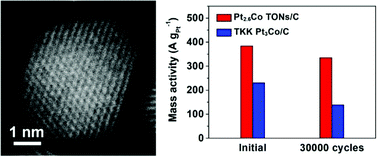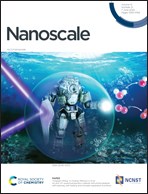Pt–Co truncated octahedral nanocrystals: a class of highly active and durable catalysts toward oxygen reduction†
Abstract
We report a facile and scalable synthesis of Pt–Co truncated octahedral nanocrystals (TONs) by employing Pt(acac)2 and Co(acac)2 as precursors, together with CO molecules and Mn atoms derived from the decomposition of Mn2(CO)10 as a reductant and a {111} facet-directing agent, respectively. Both the composition and yield of the Pt–Co TONs could be varied through the introduction of CHCl3. When tested at 80 °C using membrane electrode assembly (MEA), the 4 nm Pt2.6Co TONs gave a mass activity of 294 A gPt−1 at beginning-of-life (BOL) and it increased to 384 A gPt−1 during recovery cycles. The mass activity at BOL only dropped by 24% after 30 000 voltage cycles at end-of-life (EOL) in a metal dissolution accelerated stress test. The Pt2.6Co/C catalyst outperformed the commercial TKK Pt3Co/C (230 A gPt−1 at BOL and 40% loss after 30 000 cycles at EOL) in terms of both activity and durability. Our systematic analysis suggested that the enhancement in activity can be attributed to the combination of small, uniform size and well-defined {111} facets. This new class of catalysts holds promise for applications in proton-exchange membrane fuel cells.

- This article is part of the themed collection: Celebrating 60 years of the Fujian Institute of Research on the Structure of Matter


 Please wait while we load your content...
Please wait while we load your content...